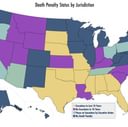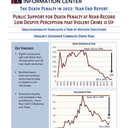FOR IMMEDIATE RELEASE CONTACT: Brenda Bowser Tuesday, December 14, 2004
DEATH PENALTY NUMBERS IN 2004 CONTINUE DRAMATIC FIVE-YEAR DECLINE
DPIC’s Year End Report Highlights Drops in Death Sentences, Executions, Death Row Population, and Public Support for Capital Punishment
WASHINGTON, DC – A five-year decline in death sentences, a 40% drop in executions, a shrinking death row population, and waning public support for capital punishment have marked a significant turn around in the use of the death penalty, according to the Death Penalty Information Center’s (DPIC) 2004 Year End Report. DPIC’s numbers are for 2004 and reinforce figures for 2003 that were released in November by the Bureau of Justice Statistics.
Other important developments in 2004 also indicate changes in the death penalty picture. In New York, the state’s highest court found its death penalty statute to be unconstitutional, and in New Jersey, questions about the method of execution have put all cases on hold. In Texas, prominent leaders and editorial boards are calling for a moratorium on executions, and legislators in California, the state with the largest death row, have commissioned a study of capital punishment to uncover flaws in the system. The U.S. Supreme Court heard arguments to determine the constitutionality of executing juvenile offenders, and Congress passed the Innocence Protection Act to help prevent wrongful convictions.
“The events of the past year and the statistical evidence all point in one direction,” said Richard Dieter, DPIC Executive Director. “The public’s confidence in the death penalty has seriously eroded over the past several years. Because of so many failures, the death penalty is rightly on the defensive. Life-without-parole offers the public a better alternative without all the risks and expense.”
The number of people sentenced to death annually has dropped by 50% since 1999. The Bureau of Justice Statistics reported 144 death sentences in 2003, the lowest number in three decades, and DPIC projects an even smaller number this year based on figures for the first three quarters of 2004. If the current rate continues, there will be 130 death sentences this year. In addition, the number of individuals on death row declined from 3,504 in 2003 to 3,471 in 2004. Executions also fell by 10%, down from 65 in 2003 to 59 in 2004. This represents a 40% drop since 1999. Of the executions that did take place, only two states conducted executions outside of the south, which accounted for 85% of the executions.
Public support for the death penalty continued to erode in 2004. When respondents were given a choice between the death penalty and life-without-parole as the appropriate sentence for first-degree murder, 50% of those polled favored the death penalty and 46% favored life without a parole. In 1997, the difference between these two choices was 32 percentage points.
Concerns about innocence continue to be a principal reason for the decline in the use of the death penalty. Five people were exonerated from death row in 2004, bringing the total number of exonerees since capital punishment was reinstated to 117. This crisis has led to a series of calls for either significant reform of the death penalty or a complete cessation of executions. Prominent political leaders, Supreme Court Justices, and law enforcement officials in Texas and elsewhere have come to the conclusion that the present system can no longer be tolerated.
The 2004 Year End Report is the 10th of its kind published by DPIC, a non-profit organization serving the media and the public with analysis and information on capital punishment.
Death Penalty Numbers in 2004 Continue Five-Year Decline
Related News & Developments



